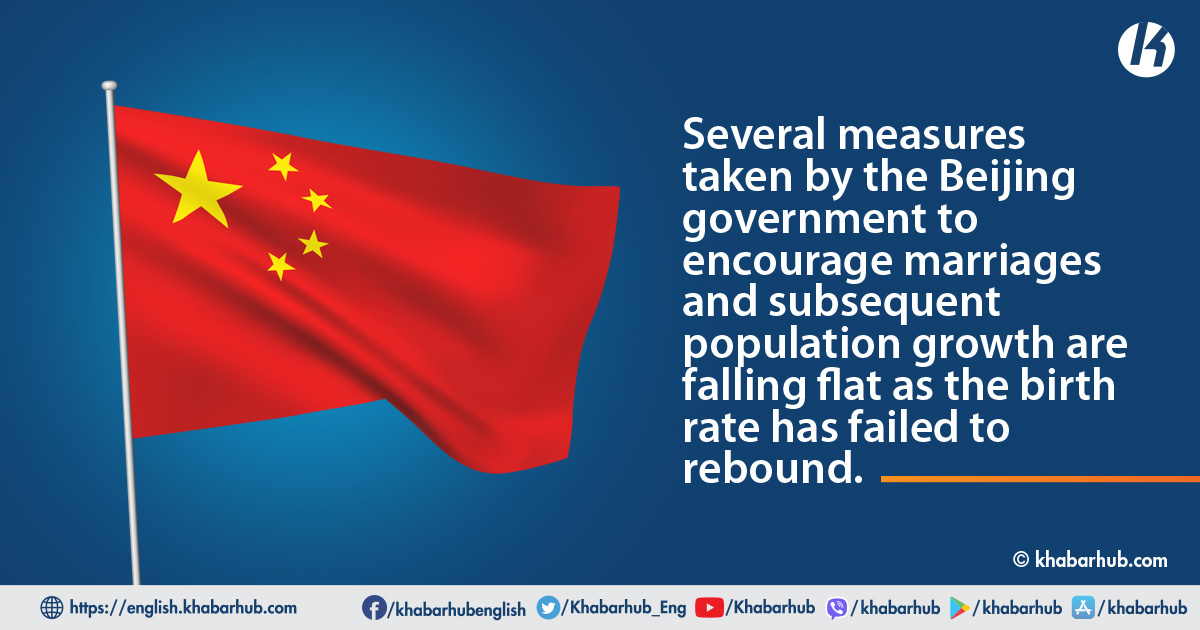Amid the challenges posed by a rapidly aging population, China has witnessed a significant 50 percent decline in the number of marriages over the span of a decade.
Compounding this issue, there is a growing trend among couples to adopt a “no-child” attitude, exacerbating China’s demographic crisis.
Despite the implementation of various measures by the Beijing government to promote marriages and encourage population growth, the birth rate has remained stagnant, thwarting their efforts.
This mounting concern is giving rise to a substantial socio-economic problem in China, particularly when viewed in conjunction with the aging population and the declining number of reproductive-aged women.
Back in 2013, China recorded 13.5 million marriage cases across the country. However, since then, the number of marriages has been steadily declining at a rapid pace.
By 2019, the figure had dropped to 9.3 million, and in 2021, it further plummeted to 7.63 million. Despite the Chinese government’s introduction of incentives and encouragement, they have been unable to reverse this troubling trend.
Delayed and lesser marriages, along with the falling number of reproductive-aged women, are causing the ageing population to grow faster.
According to the latest data released by the Chinese Ministry of Civil Affairs, the number of marriages in China further declined to 6.8 million in 2022, marking a significant 10.5 percent decrease in just one year. This alarming trend highlights the growing distress and disinterest among Chinese youths towards marriage.
Guangdong-based independent demographer, He Yafu, points out that China is currently experiencing its lowest marriage rate since 1980.
The declining youth population, imbalanced sex ratio, preference for late marriages, financial anxiety due to higher living costs and child-rearing expenses, as well as extravagant betrothal wedding gifts, are among the major reasons contributing to the falling marriage rate in China.
Additionally, factors such as unemployment and disruptions caused by the Covid pandemic are also contributing to the problem.
To improve the birth rate, China abolished the notorious one-child policy in 2016 and introduced various facilities and incentives, including cross-regional marriage registrations, cash rewards for having a second or third child, and free college education. However, despite these efforts, the situation has shown no signs of improvement.
With greater economic independence, marriage is no longer seen as a necessity for Chinese women or a prerequisite for sexual relationships among the youth. Many now prioritize building their careers and are deterred by the prospect of painful childbirth.
As a result, there has been a surge in “DINK” (double income, no kids) families in China. This lifestyle choice is gaining popularity as it provides more freedom and autonomy.
A significant percentage of Chinese college students have stated that their decision to have children depends on their economic situation.
Surveys have also indicated that a considerable portion of Chinese women are unsure if they will ever get married, and a majority cite not wanting to have children as their primary reason for this stance.
The younger generation, known as “Gen Z,” has shown a decreasing willingness to get married. Senior officials have attributed this lack of interest in marriage to prolonged schooling years, greater employment pressure, and stressful living conditions.
Experts warn that the current situation poses a demographic time bomb for China. Beijing’s efforts to address the looming demographic crisis are severely challenged by the attitudes of young Chinese towards marriage.
Adding to the concern, the number of women of childbearing age has also significantly decreased, dropping by 46 million within a decade, from 380 million in 2010 to 334 million in 2020. This demographic shift further compounds the challenges faced by the nation.
All this is going to cause a potential slowdown in domestic demand and economic growth in China, said Hong Kong-based economist Zhang Zhiwei.
The impact of an aging population in China has been evident in the decline of reproductive-aged women by five million per year between 2016 and 2021.
Yang Zongtao, an official at the Ministry of Civil Affairs, emphasized the close relationship between marriage and reproduction, stating that the declining marriage rate directly influences the birth rate, thereby affecting economic and social developments.
The trend of delayed and fewer marriages, coupled with the decreasing number of reproductive-aged women, is contributing to the rapid growth of the aging population. Consequently, there is a reduced availability of the workforce, even as social liabilities continue to increase.
Economist Zhang Zhiwei, based in Hong Kong, predicts that these factors will likely lead to a potential slowdown in domestic demand and economic growth in China.
Dr. Xiujian Peng, a senior research fellow at the Center of Policy Studies, also expresses concern over the declining and aging population, highlighting its profound impact on China’s economy both in the present and stretching all the way to the year 2100.
The combination of these factors poses significant challenges for China’s future economic and social landscape, and addressing the implications of the aging population becomes crucial for the country’s long-term development.









Comment